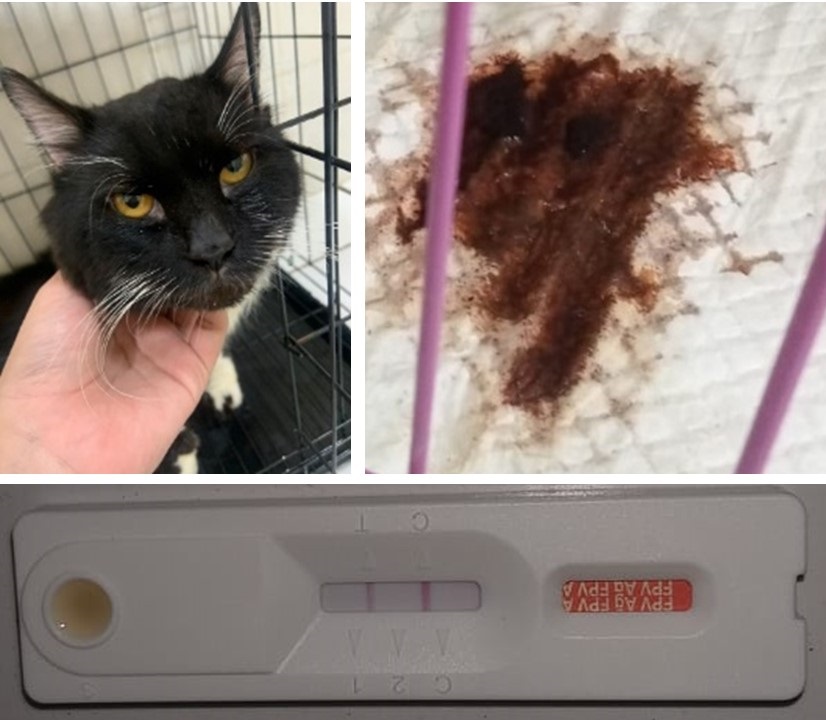Management of panleukopenia in domestic cats at Veterinary Teaching Hospital of Hasanuddin University
Abstract
Feline panleukopenia virus (FPV) is a viral disease with the main causative agent being a virus in the Parvoviridae family, which is highly contagious and can attack young cats that are clinically characterized by leukopenia, vomiting, depression, dehydration, and diarrhea. Clinical examination revealed dehydration, yellow vomiting, and bloody diarrhea. A supportive examination in the form of a rapid test marked by the presence of lines in panels C and T shows positive results for infection with the feline panleukopenia virus. Treatment of FPV cases was carried out with supportive therapy in the form of Ringer lactate fluid, multivitamins combined with imboost, antibiotics in the form of ceftriaxone, and anti-inflammatory drugs in the form of tolfedine for 7 days. The cat's condition experienced significant improvement and responded well to the treatments given. The patient was discharged on the seventh day with a normal body condition.
Downloads
References
Albab U, Febrianth A, Hermawan IP, Kurnianto A, 2022. Studi kasus: Feline panleukopenia virus pada kucing abel. VITEK: Bidang Kedokteran Hewan. 12(2): 1-4. https://doi.org/10.30742/jv.v12i2.113
Albarellos GA, Kreil VE, Landoni MF. 2007. Pharmacokinetics of ceftriaxone after intravenous, intramuscular and subcutaneous administration to domestic cats. Journal of veterinary pharmacology and therapeutics. 30(4): 345-352. https://doi.org/10.1111/j.1365-2885.2007.00871.x | PMid:17610408
Dawson S, Willoughby K, Gaskell RM, Wood G, Chalmers WSK. 2001. A field trial to assess the effect of vaccination against feline herpesvirus, feline calicivirus and feline panleukopenia virus in 6-week-old kittens. Journal of Feline Medicine Sur-gery 3(1): 17-22. https://doi.org/10.1053/jfms.2000.0154 | PMid:11716626
Jayalie VF, Made Ngurah S, Cynthia W, Leonard N. 2015. Prinsip imunokromatografi imunoglobulin a saliva sebagai metode deteksi dini dan cepat virus dengue secara noninvasif. Jurnal Mahasiswa Kedokteran Indonesia 2(3): 21-28.
Kahn CM. 2010. The Merck Veterinary Manual. 10th ed. Inc. New Jersey. Merck and Co. pp.345-351.
Marlissa FCM, Suartha IN, Widyastuti SK. 2022. Laporan Kasus: Penanganan Panleukopenia pada Kucing Kampung Usia Muda yang Belum Pernah Divaksinasi. Indonesia Medicus Veterinus. 11(4): 206-213. https://doi.org/10.19087/imv.2022.11.4.579
Tilley P, Smith JR. 2011. Blackwell's Five-Minute Veterinary Consult: Canine and Feline. 5th ed. John Wiley and Sons. Inc.
Truyen U, Addie D, Belák S, Boucraut-Baralon C, Egberink H, Frymus T, Gruffydd-Jones T, Hartmann K, Hosie MJ, Lloret A, Lutz H. 2009. Feline panleukopenia. ABCD guidelines on prevention and management. Journal of Feline Medicine and Surgery. 11(7): 538-546. https://doi.org/10.1016/j.jfms.2009.05.002 | PMid:19481033 PMCid:PMC7129762
Ulum MM, Zubaidah M, Arief M. 2018. The influence of supplemented Curcuma in feed formulation to improve growth rate and feed efficiency of catfish (Clarias sp.). IOP Conference Series: Earth and Environmental Science 137(1): 12007. https://doi.org/10.1088/1755-1315/137/1/012007
Ye JH, Ponnudurai R, Schaefer R. 2001. Ondansetron: a selective 5‐HT3 receptor antagonist and its applications in CNS‐related disorders. CNS drug reviews. 7(2): 199-213. https://doi.org/10.1111/j.1527-3458.2001.tb00195.x | PMid:11474424 PMCid:PMC6741689

Copyright (c) 2023 CC-BY-SA

This work is licensed under a Creative Commons Attribution-ShareAlike 4.0 International License.
Authors who publish with this journal agree to the following terms:
1. Authors retain copyright and grant the journal right of first publication with the work simultaneously licensed under a Creative Commons Attribution License that allows others to share the work with an acknowledgement of the work's authorship and initial publication in this journal.
2. Authors are able to enter into separate, additional contractual arrangements for the non-exclusive distribution of the journal's published version of the work (e.g., post it to an institutional repository or publish it in a book), with an acknowledgement of its initial publication in this journal.
3. Authors are permitted and encouraged to post their work online (e.g., in institutional repositories or on their website) prior to and during the submission process, as it can lead to productive exchanges, as well as earlier and greater citation of published work (See The Effect of Open Access).

.jpg)















